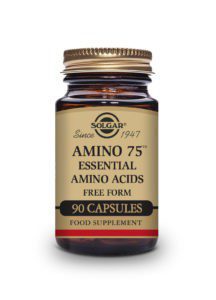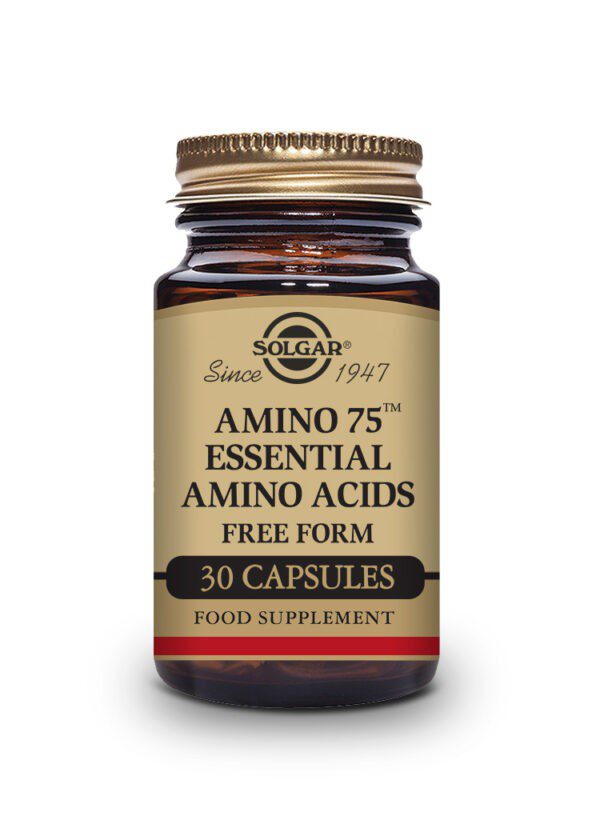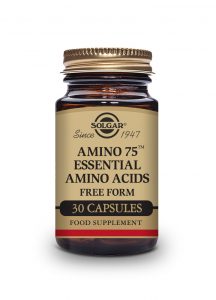





Amino 75 (Amino Acids) Solgar
£13.56 – £33.59
Amino Acids
Amino acids are organic compounds that serve as the building blocks of proteins in living organisms. They are essential for various biological processes, including the synthesis of proteins, enzymes, hormones, neurotransmitters, and other molecules necessary for the proper functioning of the body.
Solgar Amino 75 are made up of an amino group (-NH2), a carboxyl group (-COOH), and a side chain (also called an R-group), all bonded to a central carbon atom.
There are 20 standard amino acids that are commonly found in proteins. They can be categorized into three groups based on their interaction with water:
1. **Nonpolar Amino Acids:** These amino acids have hydrophobic (water-repelling) side chains, making them more likely to be found in the interior of protein structures away from water.
Examples: Glycine, Alanine, Valine, Leucine, Isoleucine, Methionine, Phenylalanine, Proline, Tryptophan.
2. **Polar Amino Acids:** These amino acids have hydrophilic (water-attracting) side chains, making them more likely to be found on the surface of protein structures, interacting with water and other polar molecules.
Examples: Serine, Threonine, Cysteine, Tyrosine, Asparagine, Glutamine.
3. **Charged Amino Acids:** These amino acids have charged side chains, which can be either positively charged (basic) or negatively charged (acidic).
Positively Charged: Lysine, Arginine, Histidine.
Negatively Charged: Aspartic Acid (Aspartate), Glutamic Acid (Glutamate).
Amino acids are crucial for various physiological processes:
– **Protein Synthesis:** Amino acids are joined together through peptide bonds to form proteins. The sequence and arrangement of amino acids in a protein dictate its structure and function.
– **Enzyme Function:** Many enzymes are proteins, and their active sites often include specific amino acids that are essential for catalyzing biochemical reactions.
– **Neurotransmitter Production:** Amino acids such as glutamate, glycine, and GABA (gamma-aminobutyric acid) are neurotransmitters that play a role in transmitting signals between nerve cells.
– **Hormone Synthesis:** Amino acids are used to create various hormones in the body, such as insulin and growth hormone.
– **Immune System Function:** Amino acids are necessary for the production of antibodies and immune system components.
– **Cellular Signaling:** Some amino acids act as signaling molecules that regulate processes like cell growth, metabolism, and gene expression.
A balanced diet rich in protein sources, such as meats, fish, dairy products, legumes, nuts, and seeds, is important to ensure an adequate intake of essential amino acids. In some cases, amino acid supplements may be recommended under the guidance of a healthcare professional, especially for individuals with specific dietary restrictions or medical conditions.
Amino acids supplements are intensifies that join to shape proteins. Normally available in our bodies, they’re frequently to as the “building squares of life.” They are require for the creation of proteins, just as certain chemicals and synapses.
They’re likewise engage with various metabolic pathways inside cells all through the body. You can acquire through the food sources you eat.
Later your body processes and separates protein, these are pass on in the body to assist with doing the accompanying:
List of Amino Acids
Amino Essential combines the 8 essential amino acids L-Lysine, L-Leucine, L-Phenylalanine, L-Valine, L-Methionine, L-Histidine, L-Isoleucine and L-Threonine. BCAA
Amino Foods
Eggs, Turkey, Cottage cheese, Mushrooms, Fish, Legumes and Beans, Quinoa
Amino-Acids supplements
Solgar L- Lysine 500mg /100mg, Lamberts BCAA Powder, Solgar L-Phenylalanine Capsules, Solgar L-Glutamine capsules
Altreint L-Glutathione, Vridian L-Cysteine, Now Foods L-Ornithine, Now Foods Arginine
Is It Harmful?
When your body has too much then following effects can occur:
- Gastrointestinal distress, such as bloating
- Abdominal pain
- Diarrhea
- Increased risk of gout (buildup of uric acid in the body, leading to joint inflammation)
- Unhealthy drop in blood pressure
- Changes in eating patterns
- Need for your kidneys to work harder to maintain balance
Ingredients
Vegetable Capsule Shell: hydroxypropylmethyl cellulose, L-Lysine (as HCI) (Free Form), L-Leucine (Free Form), L-Phenylalanine (Free Form), L-Valine (Free Form).
L-Methionine (Free Form), L-Histidine (Free Form), L-Isoleucine (Free Form), L-Threonine (Free Form), Bulking Agents(microcrystalline cellulose, hydroxypropyl cellulose), Anti-caking Agents (vegetable magnesium stearate), Cellulose Gum.

















Reviews
There are no reviews yet.